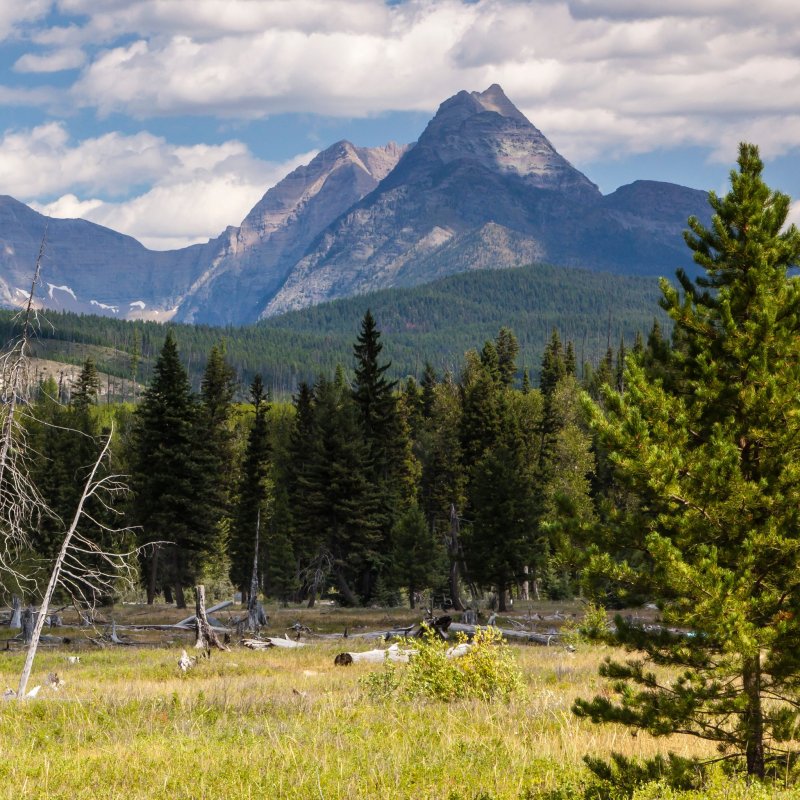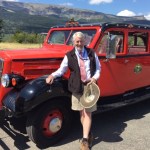
The North Fork of Glacier National Park is a hidden gem with great hiking, spectacular views, plenty of wildlife, and a quirky store called Polebridge Mercantile.
Videos by TravelAwaits
The North Fork is a 40-mile drive from the west entrance to the park. The first 11 miles are paved, but the remainder of the drive is rough and rocky. If you go, be sure to know how to change a flat tire.
The challenging road is a main reason so few people visit the region.
On the way to the stunning lakes, it’s almost a requirement to stop at the old-fashioned Polebridge Mercantile. The place was built in 1914, just four years after the park was created. Bill Adair built the general store, which catered to the 150 or so families in the Flathead River valley.

Today, it’s a must-stop for those visiting the region. The store is noted for its incredible huckleberry bear claws. They are always baking them, so the chance of biting into one steaming from the oven is very high. The store is full of touristy things, like ball caps and refrigerator magnets. But it’s also a general store, serving the community of farmers, ranchers, and campers.
The mercantile also has some cabins to rent. They are rustic and there’s no running water in them. They are popular and reservations are a must.
Next door to the mercantile is the only restaurant for miles around, The Northern Lights Saloon. And you are north here, just about 20 miles from the Canadian border. However, you can’t drive easily to Canada since the closest border crossing has been closed for several years. The next closest is a two-plus hour drive.
After fortifying yourself at the mercantile with baked goods, leave time enough to burn off those calories. There’s spectacular hiking in the North Fork area. The roads are rocky and narrow but navigable. A vehicle with a high clearance is best, so leave your Corvette in the garage!

Ed Daniel
Bowman Lake To Numa Ridge
Leave Polebridge and head northeast to Bowman Lake. It’s just a 7.5-mile drive, but it’ll take all of 30 minutes to get there. You’ll be driving along the Inside North Fork Road. About halfway to the lake, you’ll come to the Polebridge entrance station. Here’s where you may learn that there’s no parking available at Bowman Lake. Heed the advice of the ranger. If there is parking, and there should be earlier in the day (and the season), you’ll be heading to Numa Ridge.
It’s a great little hike that takes you to a fire lookout tower, and with luck, there will be a person working there. Often, the fire watchers are happy to give a tour of their workspace, which doubles as their living space. It’s a sparse existence, but watchers I’ve met over the years wouldn’t give up the experience for love or money. If the tower stairs are blocked with a chain, don’t visit.
The hike starts to the left of Bowman Lake parking lot and it’s clearly marked. As you get going, you’ll see a house to your left and in the lake, on the left, a boat. This house is the ranger’s residence. If he/she is in the yard, they’ll often be willing to talk about the area and give you any updates on hikes in the area. Do not enter the property. Remember, this is someone’s home.

Ed Daniel
The walk to the tower is along Bowman Lake, along a ridgeline, and it’s a moderately strenuous walk, just about 11 miles long roundtrip. The elevation gain is about 3,000 feet. The stroll is in forest most of the way, so the views are limited to peeks of Bowman Lake. After about five miles, you come up the ridge and the views improve considerably. Then it’s a short walk to the tower.
Even if the tower is closed, there are great views from the top of the ridge, especially of Mount Carter across Bowman Lake. Carter is one of the tallest peaks in Glacier, at 9,800 feet.

Ed Daniel
Quartz Lake Loop
This hike gains about 1,500 feet in elevation, but it takes you up and down, with an 1,100-foot elevation loss. The moderately difficult hike has a lot to offer: views of the Quartz Lakes, a stroll through a forest burned in 1988, which is giving way from fireweed to young lodgepole pine trees, and views of mountains in the Livingston Range.
This hike is almost 13 miles long, so you need to get an early start and bring plenty of water, but it’s a loop, so you end up where you started and you don’t see the same thing twice. The hike starts opposite where the hike to Numa Ridge begins, on the south side of the parking area.
When you get to a fork in the trail, just past Bowman Creek, which drains the lake, go left and you’ll enjoy an easier walk. A right takes you along a much steeper path. Trust me: Go left. The trail rises to the top of Cerulean Ridge and then down into the Quartz Lake drainage. It’s lowlands and drops to a campground at the foot of Quartz Lake.
The trail follows Quartz Creek, and you climb back up through a burn area that is teeming with new life: grasses, fireweed, and, if you are lucky, bear grass. Bear grass isn’t a grass but a member of the lily family. The flowers are in a bunch at the top of a stalk.

Ed Daniel
Logging Lake
This stroll is relatively easy and covers just about 8.5 miles round trip. You follow Logging Creek and eventually walk along the lake itself. The elevation gain is less than 500 feet, so it is not at all difficult. The views are limited until you get to the lake itself, and then the vistas open up.
The trail takes you through several burn areas, and while they look devastated, realize the National Park Service says fire is a natural part of the forest landscape. The park is regenerating thanks to fire. The larger burn area is the result of the 2001 Moose Fire, and the smaller burn happened in 1994.
There’s a greater diversity of flora growing in the burn areas and they will eventually become a forest. The first plant that colonizes after a burn is fireweed, which holds the soil for the other plants to get going. The first tree to move in is the lodgepole pine. The tree has a cone that is sealed with a thick resin. The only time the cone opens is when there’s a fire and it tosses seeds everywhere. You multiply all those seeds by all those cones and all those trees, and in 20 years or so, you get a brand new forest. That’s what’s happening in all the burn areas.

Ed Daniel
You can stop at the foot of Logging Lake and look for eagles in the air. They nest at the head of the lake and take their young on far-ranging fishing expeditions. You can keep walking along the lake and keep your ear tuned for the sound of loons. There’s lots of wildlife along the trail in the valley. Look for deer, moose, and squirrels. The word is that mountain lions inhabit the area, which is not busy with hikers, but the word on lions from rangers is that you never see them until they are jumping on your back.
This part of the park is one of the least visited and has limited services, so bring plenty of water and patience, as the roads can be harrowing if you confront another motorist coming in the opposite direction.
Fortunately, that’s never a problem on the hiking trails.
Want more? Read up on the best hikes in Glacier National Park.
